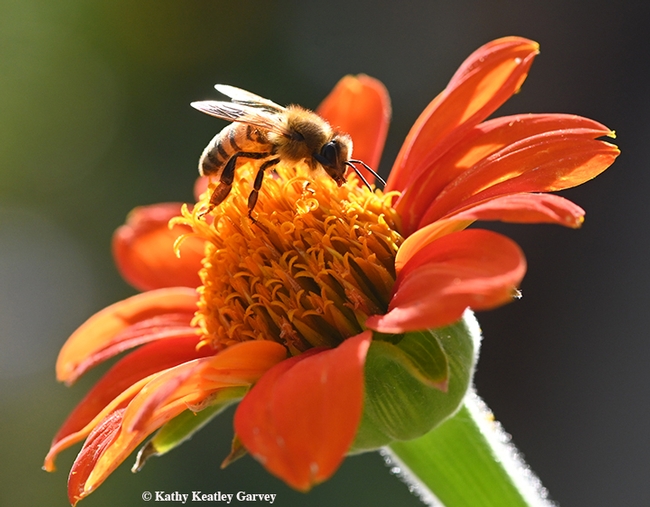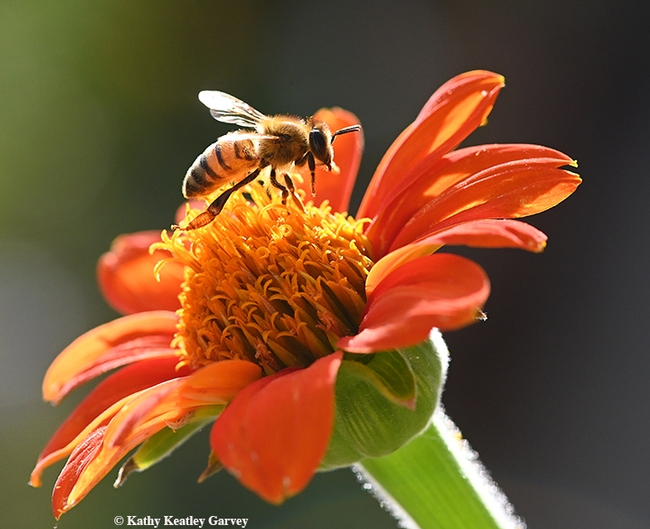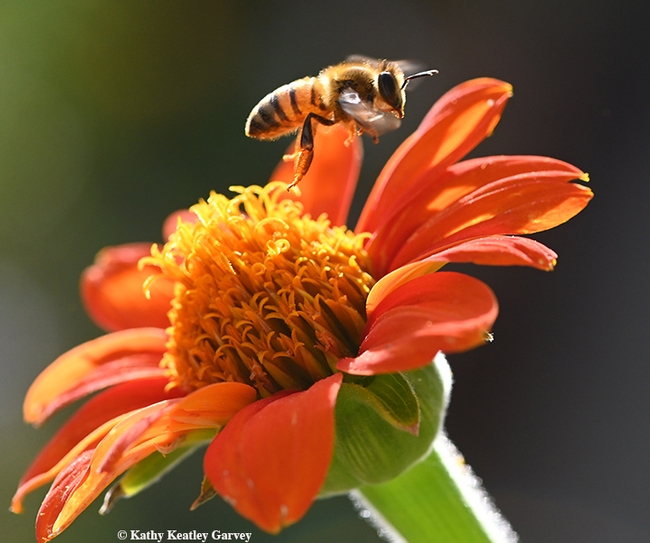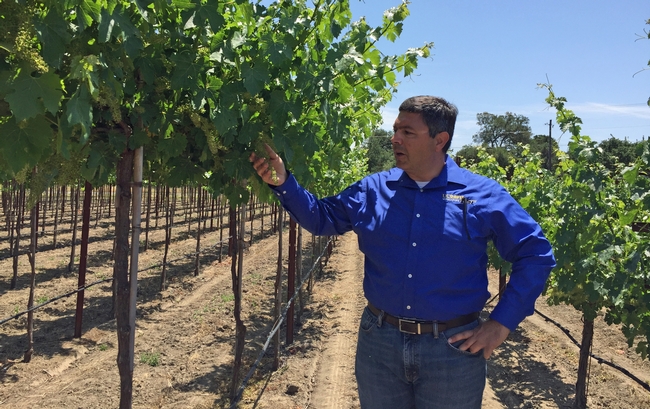Posts Tagged: labor
Happy Labor Day from a Gulf Fritillary
Happy Labor Day! And what an appropriate time to post an image of a Gulf Fritillary, Agraulis vanillae, depositing an egg! The females...

A Gulf Fritillary, Agraulis vanillae, laying an egg on Labor Day weekend in Vacaville, Calif. (Photo by Kathy Keatley Garvey)
The Laborious Honey Bee
Today is Labor Day 2019, a federal holiday celebrated the first Monday of September. However, "the girls" are working, as they do every day of the...

A worker honey bee forages on a Mexican sunflower (Tithonia) in the magic hour, the hour before sunset. (Photo by Kathy Keatley Garvey)

Illuminated by the late afternoon sun, the worker bee prepares to fly to another Tithonia blossom. (Photo by Kathy Keatley Garvey)

A worker bee takes flight, lifting over a Mexican sunflower (Tithonia). (Photo by Kathy Keatley Garvey)
The winegrape industry is well suited to mechanized production
A major expense in producing winegrapes is labor. Two UC Cooperative Extension experts appeared on the Jefferson Exchange radio program to explain how mechanization of pruning, leaf removal and shoot thinning, combined with mechanized harvesting widely implemented decades ago, will dramatically reduce the need for labor in California winegrape production.
"The minimum wage is going to increase to $15 per hour in 2022," said George Zhuang, viticulture advisor with UCCE Fresno County. Besides, it is getting more challenging for growers to find enough workers due to labor shortages and higher wages in other fields, such as construction.
The machinery for mechanized vineyards requires an investment of about $100,000, said Kaan Kurtural, UCCE viticulture specialist. At that cost, growers begin to break even after a year.
The biggest obstacle to mechanization is the way winegrape vineyards have traditionally been trellised. The cross arms get in the way of machines as they go through the vineyards. In a recent research project by Zhuang and Kurtural, the scientists converted a traditional system to single high wire and managed it with mechanical equipment.
"It was more profitable ... with the same, if not better, quality and value at the farm gate," Kurtural said. "The writing is on the wall for growers to adapt to this as quickly as possible."
Host Geoffrey Riley asked whether the labor savings will result in cheaper wine. Kurtural laughed.
"No," he said. "Wine prices are set by market demand. I don't think wine is an expensive beverage."
The U.S. is running out of farmworkers
No matter what happens with immigration reform, the United States will likely suffer a shortage of farm labor in coming decades, reported the Washington Post. The story was based on a study titled "The End of Farm Labor Abundance" by Edward Taylor, professor in the Department of Agriculture and Resource Economics at UC Davis, UC graduate student Diane Charlton and Antonio Yúnez-Naude, professor in the Center for Economic Studies at El Colegio de Mexico in Mexico City.
“It’s a simple story,” Taylor said. ”By the mid-twentieth century, Americans stopped doing farm work. And we were only able to avoid a farm-labor crisis by bringing in workers from a nearby country that was at an earlier stage of development. Now that era is coming to an end.”
Since it is unlikely that another labor pool can be found, and also unlikely that American demand for fresh fruit, vegetables and nuts will decline, farmers could turn in greater numbers to mechanical options, such as shake-and-catch harvesting machines, the study said.

Mechanical harvesting of cling peaches.
California farmers fear labor shortage, but experts are skeptical
Farmers say traversing the Mexico-U.S. border has become more difficult for would-be farmworkers, causing a labor shortage in California, according to an article in the San Jose Mercury-News.
"(Border crossing) is more dangerous because of the drug cartels, our government is doing a better job of enforcing the borders and the Mexican economy is doing better," said Jim Lincoln, a vintner and former president of the Napa County Farm Bureau.
Phil Martin, professor in the Department of Agricultural and Resource Economics at UC Davis, paints a different picture. He estimates the yearly number of farm laborers has remained steady in the last decade at around 800,000 people after it had expanded in the 1990s.
Martin is skeptical of perennial farmworker shortage warnings, finding no signs of diminished crops or fewer workers in a 2007 report, but five years later he says the farming community has hit "a period of uncertainty."



